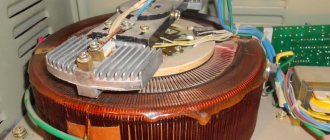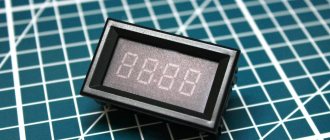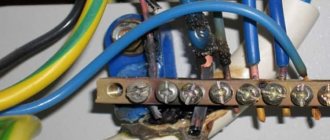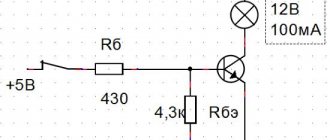As discussed in this article, there are two types of RCDs - electromechanical and electronic.
In appearance, they are practically no different from each other. It is very difficult for a simple consumer without certain knowledge and skills to figure out which RCD is electronic or electromechanical. How can you tell them apart? Are there any tools or fixtures needed for this?
There are three main ways to distinguish RCDs:
- ⚡
according to the diagram on the RCD body - ⚡
using a battery - ⚡
using a magnet
According to the diagram on the RCD body
On the body of all modern RCDs its electrical circuit is depicted. If it is not on the front of the case, look at the top.
The electronic RCD circuit is somewhat different from the electromechanical circuit. If you know these differences, you can easily recognize the type of RCD before purchasing.
Electro-mechanical RCD diagram:
- ⚡
differential transformer drawn - ⚡
a relay is drawn that is connected to a transformer - ⚡
disconnecting mechanism drawn - ⚡
the TEST button is still displayed
An example of such a scheme:
Electronic RCD diagram:
The elements that are depicted on the electronic RCD diagram are almost no different from those indicated on the electromechanical one. What's the difference? And it consists of an additional electronic board.
It is drawn in the form of a rectangle or triangle installed between the differential transformer and the relay.
Two conductors are suitable for this element - phase and neutral, that is, 220V. This is the external power required for the operation of the electronic RCD.
How to distinguish an electromechanical uzo from an electronic one
In order to understand which residual current device in front of you is electronic or electromechanical, you need to be able to distinguish between them. Many will find this difficult and will say that only professionals can do it. But I assure you this is not so, there is nothing complicated here. It is enough just to know some nuances.
So, there are several ways to distinguish an electromechanical RCD from an electronic one. After studying them, you will be able to confidently determine what type of RCD is in front of you. Now let's look at each of them in detail.
1. Scheme shown on the RCD body
The first and easiest way is to study the diagram, which is shown on the RCD body. An electrical diagram is applied to any protective device. If you learn to read and recognize these patterns, you can easily determine not only the type of device. By the way, if you remember, in the article on how to distinguish an RCD from a difavtomat, we have already encountered similar circuits. If you look closely, there are slight differences between the displayed circuits on the electromechanical RCD and the electronic one .
The diagram of an electromechanical RCD or automatic circuit breaker shows a differential transformer (through which phase and zero are “passed”), the secondary winding of this transformer, as well as a polarized relay that is connected to the secondary winding. The polarized relay already directly acts on the shutdown mechanism. All this is shown in the diagram. You just need to understand what figure represents each of the above elements.
The differential transformer is marked as an oval around the phase and neutral wires. A turn of the secondary winding departs from it, which is connected to a polarized relay. In the diagram, a polarized relay is indicated as a rectangle or square (in our case it is a square). The dotted line from the relay indicates a mechanical connection to the shutdown trigger.
There is also a TEST button with its own resistance (the resistance allows you to create a leak of the calculated value). As you can see, there are no electronic boards or amplifiers in an electromechanical RCD. The design consists of pure mechanics.
Now let's look at the electronic RCD. For example, I will use an electronic circuit breaker from IEK brand AVDT32 C20, with a leakage current of 30 mA.
As can be seen from the diagram, almost everything is indicated on the body of the electronic automatic machine as on the electromechanical protective device.
But if you look closely, you can see that between the differential transformer and the polarized relay there is an additional element in the form of a rectangle with the letter “A”. This is the same electronic board with an amplifier.
In addition, you can see that two wires “phase” and “zero” are suitable for this board. This is precisely the external power source that is necessary for the full operation of this type of RCD.
There will be no power, and the RCD will not work. Regardless of whether there is a leak or not.
2.External power source - test using a battery.
The second way to distinguish an electromechanical ouzo from an electronic one is a little more complicated than the first, since you need to have additional elements with you - a battery and wires for connection. It seems nothing complicated, but you must admit that they are not always convenient to use, especially if you are in a store. The market may still allow you to use them, but in the leading stores of electronic products they will definitely refuse you this (well, what kind of manager would agree to have ouzo or diff smoked in front of him).
So, for the test we will need the most ordinary charged battery, any (finger-type, crown, etc.) I had a 9 V crown-type battery on hand.
We take an electromechanical RCD, screw one wire to the top terminal, and screw another wire to the bottom terminal of the SAME POLE. I would like to note that it does not matter at all to which pole you screw the wires to - phase or neutral. But if you connect the wire to the phase pole terminal at the top, then you also need to connect the wire to the phase pole at the bottom, otherwise there will be no closed circuit.
Now we turn on our RCD (RCBO) and close the ends of the protruding wires to the battery. At the moment when the lead is closed to the battery terminals, current will begin to flow through the pole of the RCD. The RCD should turn off.
If this does not happen, change the polarity of the battery, that is, swap the “+” and “-” poles. If the RCD turns off, we can say with 200% confidence that it is of an electromechanical type .
An electronic RCD will not react to such a test in any way, because for it to operate additionally requires the presence of voltage on the electronic board.
3.Use a permanent magnet
We turn on the RCD, take a permanent magnet and move it along the body. Under the influence of a magnetic field, a current is induced in the secondary winding of the differential transformer, the polarized relay is activated and the RCD is turned off. This will all happen if the protective device is electromechanical.
This method has a certain error, but has the right to life. The first is that the magnet may not be strong enough, the second is that for each brand of protective device the working elements are located in different areas. What I mean? For example, for Schneider Electric the differential transformer may be located on the right side of the housing, for ABB in the middle of the housing, for IEK it may be on the left. Visually, the insides are not visible.
Therefore, when using this method for each model of protective device, you need to “probe” the area in which you need to move the magnet. Not everyone is able to find this area and the wrong conclusions can be drawn.
If you liked the article, share it with your friends!
Checking the RCD using a battery
Necessary equipment for testing:
- ⚡
battery (pen or crown) - ⚡
two wires 10-15cm long
The verification process is as follows. Connect one of the wires to the upper contact of the RCD, the other wire to the lower contact. The main thing is that the contact is single-pole, i.e. either the phase of the same name (if it is a 3-phase RCD), or zero. And close the wires to the plus and minus of the battery.
If the RCD does not turn off, reverse the connection poles of the wires on the battery. If it didn’t work this time, it means the RCD is electronic.
Triggering of an RCD means that it is of the electromechanical type.
External difference between electronic and electromechanical RCDs
On the body of the differential switch there are markings and a circuit diagram for switching on this type of device. On the displayed diagram of the electromechanical device you can see a differential transformer, its secondary winding with a connected polarized relay and a dotted line showing the connection of the relay with the trigger mechanism.
Diagram of an electromagnetic RCD (left) and electronic (right)
The “TEST” button with a resistor is also indicated. In the electronic form of the device on the case, you will find the difference in the circuit in the additional triangle with the designation A of the electronic amplifier between the transformer and the polarized relay and the connection of this triangle with the power wires, phase and zero.
Electromechanical and electronic RCD for an apartment, which is better?
Nowadays you won’t surprise anyone with the presence of an RCD in the electrical panel.
Most realized that this was a necessity, not an excess. However, not everyone knows that RCDs are different. They are all the same in appearance, but the internal design can differ significantly. Depending on the design of internal protection, RCDs can be electromechanical or electronic.
More correctly, of course, they should be called functionally dependent and voltage-independent circuits.
How can you tell them apart and what is the difference between their work?
Electromechanical residual current device
In order for an electromechanical RCD to turn off, only one condition is needed:
In this case, the source of energy to turn off the device is the signal itself, i.e. differential current to which it reacts. In this case, the operation of the RCD does not depend on whether there is 220V voltage in the wiring or not .
There is a small transformer inside the device. Which plays more of an actuator role than a signal one (unlike an electronic one). As soon as a leakage current appears in the protected wiring, a voltage is created in the transformer winding, which causes the relay to operate, after which the RCD itself is mechanically switched off.
Electronic residual current device
In order for the electronic RCD to turn off, two conditions are already needed:
- ⚡
there is a leakage current - ⚡
there is voltage in the network
This means that there must be an external power source for it to work. The main element of such RCDs is an electronic board. And for it to work there must be an external voltage source.
Where can I get it? This is not some kind of battery or accumulator. The external source is the 220V voltage in the network itself. Thus, if there is no voltage suitable for the RCD, this device will not operate .
On the basis of such electronic RCDs, such household protection devices as RCD sockets or RCD plugs are often manufactured.
For example, in Europe, in some countries, it is prohibited to apply a quality certification mark to all devices of this type (depending on the voltage in the circuit). Moreover, they are allowed to be installed in the network only after devices that do not depend on the power supply of the circuit.
Recently, electronic RCDs have begun to be manufactured abroad, which initially include the function of shutting down the entire consumer electrical installation if the voltage in the RCD circuit disappears. In the USA, such devices are initially built into socket blocks.
In Russia, according to the recommendations for the use of RCDs from the set of rules “Electrical installations of residential and public buildings” - in residential buildings it is not allowed to use residual current devices that automatically disconnect the consumer from the network when the voltage disappears or is not allowed to decrease.
Reasons for failure of electronic RCD
When might the voltage not approach the RCD? Most often, the light in your home may disappear in the following cases:
- ⚡
short circuit of wires on the supply line or substation - ⚡
scheduled repair work - ⚡
loss-burnout of zero in the panel room (in this case, the phase will still come to your house, but you will not have 220V voltage)
The last case is the most insidious. If, under such conditions, you have a short circuit in the wiring to the equipment body (washing machine, electric titanium), the electronic residual current device will not work, even when you touch the damaged electrical equipment. There will be a leakage current, but the voltage to the RCD is not suitable and it will not turn off. If the zero burns out in the common switchboard of the entire house, where 3 phases come, this is fraught with the appearance of a linear voltage of 380V in your sockets. At such an increased voltage, the electronic filling will easily fail. If this is not accompanied by smoke or sparking, you may not even notice it.
After the accident is eliminated, the electronic RCD will no longer be operational. And you will continue to count on it and think that it provides your protection. To avoid getting into this situation, all RCDs - electronic or electromechanical - have a TEST button.
When you press this button, the RCD should automatically turn off. It should be checked in this way at least once a month , especially after each power surge.
In addition, the electronic RCD stops working normally not only when the voltage disappears, but also when it significantly decreases. You can verify this from the video:
Advantages and disadvantages
All the advantages and disadvantages of electromechanical and electronic RCDs can be summarized in one table:
Parameter RCDElectronic RCDElectromechanical RCD
| Price | Cheaper | Expensive |
| Design | Easier | More difficult |
| Sensitivity | Higher | Below |
| Operation in the event of a break in the neutral wire | No | Yes |
| Operability under significant voltage drops | No | Yes |
| Probability of failure due to surge voltages | Higher | Below |
To summarize, we can advise that the best option for installation in an apartment electrical panel is an electromechanical RCD. Moreover, today this type is most widely represented in electrical goods stores.
How to distinguish which RCD is in front of you - electromechanical or electronic - can be found in this article.
Source: https://domikelectrica.ru/elektromexanicheskoe-i-elektronnoe-uzo-dlya-kvartiry-chto-luchshe/
Uzo - electronic or electromechanical - which is better?
← New HAGER differential circuit breakers for 3-phase networks || DAV3 - Innovative Hager connection for the household segment →
To protect against current leakage, residual current switches or residual current devices (RCDs) are used. In every new apartment, new house, this device becomes a necessary equipment.
However, devices with a fundamentally different internal design, which determines the reliability of the entire RCD, can be sold under a common name.
The design may have a different arrangement of levers and control buttons, have standard or expanded options for connecting buses and wires, but the design of the RCD release .
It can be electromechanical or electronic. But how can you immediately distinguish an electromechanical RCD from an electronic one? This issue needs to be discussed in detail.
What is the difference between an electromechanical ouzo and an electronic one?
RCDs and difavtomats (this is an RCD and a circuit breaker in one housing) according to their internal design are divided into two types: electromechanical and electronic . This does not affect the operating parameters and technical specifications in any way.
Based on the principle of internal design, RCDs are divided into two types - electronic and electromechanical. Both types perform leakage current protection in the same way. Then what is their difference? In a nutshell, their difference is that the electronic RCD requires an external power supply to operate, while the electromechanical type does not need it. The same applies to automatic devices, since the RCD is their integral part.
Why does the question arise, which RCD to choose, electronic or electromechanical? Looks like you can take either one, since they perform their functions in the same way. Below we will try to deal with this issue.
Here is an example of an electronic RCD:
The amplifier board is responsible for the correct operation of the electronic RCD. For its operation, external power is required, since no board will work without it. Where can I get this external power supply? There are no batteries inside these devices, so they receive power from an external network. If there is “light” at home, then the protective device works. If there is no “light”, then it does not work, and there is no need for it to work, since there is nothing to protect from anyway. At first glance, you don’t have to think about anything else here. However, it is not.
Non-standard (emergency) situations often occur in the external power supply network of apartments. These are voltage surges that are very dangerous for electronic equipment, i.e. and for electronic RCDs and automatic devices.
Firstly, for example, the neutral conductor feeding your apartment in the floor panel has burned out. In such a situation, only one “phase” will arrive at the amplifier board. The board will no longer work, i.e. will not detect leakage current and transmit a pulse to the relay. Here the electronic RCD will not work when a leakage current appears. This is true in old houses where the electrical wiring is in poor condition. This situation is dangerous for humans.
Secondly, for example, the main neutral conductor, which runs along the entire riser of a high-rise building, burned out. There will be a change in voltage in the apartment sockets. Where a large load is turned on, the voltage in the sockets will drop and tend to zero. Where the minimum load is turned on, the voltage in the sockets will increase and tend to 380 V. In a situation with excess voltage, the electronic RCD will not work, but its amplifier board will simply fail. If a dangerous potential suddenly appears on the housing of household appliances, the RCD will not detect this leak and will not save a person from electric shock. This is also very dangerous.
There are also short-term surges or voltage drops in the network caused by other factors. They can also damage the amplifier board of the electronic RCD and damage it. You may not notice such jumps and will not know that your protective device in the shield is no longer working. It’s not for nothing that they recommend checking their work every month by pressing the “Test” button.
As you already understood, when various emergency situations occur in the power supply network, an electronic RCD may lose its protective functions.
The electromechanical RCD does not require external power and will perform its functions in all of the above situations. Therefore, it is worth choosing electromechanical RCDs and automatic devices for your home, since their design is more reliable. Read how to distinguish them here.
Here is an example of an electromechanical RCBO:
This is not the whole conclusion regarding the selection of protective devices. Let's continue...
Today they produce electronic RCDs and automatic circuit breakers with built-in overvoltage protection. For example, these are models EZ9R7... and EZ9R8... from Schneider Electric. True, they are produced only at 40 A and 63 A with protection against leakage currents of 100 mA and 300 mA. They can be used as introductory fire protection RCDs. They have built-in protection against burnout of household electrical appliances when the voltage increases to 280 V. By installing such an RCD in the panel, you can be sure that it will not fail when various voltage surges occur.
Another very good measure of protection against instability of the external network is the use of a voltage relay UZM-51M from Meander. If you install this device at the input in your distribution panel, then you can safely choose electronic RCDs and automatic circuit breakers. They will be protected from overvoltage using this relay.
As a result, which RCD to choose, electronic or electromechanical, should be decided based on the specific situation. Of course, you can take only electromechanical models and not think about anything else. However, electronic types of protective devices are sometimes cheaper and can have more compact sizes (1 module), which can be an important criterion when choosing them.
What kind of RCDs and automatic devices do you use at home?
Let's smile:
Chubais and Bill Gates once met. Chubais says: “You know, Bill, I’ll be cooler than you.” Bill Gates is left in a precipitate: - Why is this, all of a sudden? - Well, look. You are a cool businessman, I am a cool businessman. You are a monopolist, I am also a monopolist. - Well, and?.. - Just why don't you turn off those who don't pay you for Windows!!!









